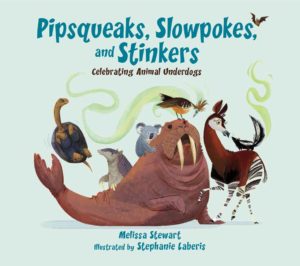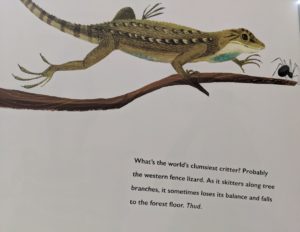Why I Picked It Up:
The title grabbed my attention immediately! Pipsqueaks, Slowpokes, and Stinkers; Celebrating Animal Underdogs. I had so much love for the title that, when it arrived, I read it before unpacking the other books.
Why I Finished It:
Besides my obvious love for underdogs, I enjoyed learning about new animals and why their traits are helpful to their survival. For example, I learned that there is a western fence lizard who is quite clumsy, but they are clumsy because they have to move so fast to catch their prey. In the end, Stewart points out that sometimes weaknesses can actually be a strength. Love this! In addition to the text being engaging, the illustrations by Laberis are as playful as the text.
Who I Would Give It To:
This picture book will be loved by everyone. I can’t even bring myself to put an age on this one. I enjoyed it as much as any kid will. Teachers, you will want this text. Promise.
Integration:
Writing – Generating Ideas.
Have students create a T-chart in their writing journal. One side generate perceived weaknesses and the other strengths. I always like to have students share at this point. Then take three ideas from either side and contemplate how it might fit in the other column. For example, I might put a strong leader as a strength, but the downside might mean that it is hard for me to take direction. I might put that I am strong-willed as a strength, which could mean I’m pushy or unable to compromise.
Have students choose one idea and emulate the structure from Stewart. Example:
Why is it so hard for me to compromise? It is because I am super passionate
about my ideas. It makes it hard to change focus.
Then have students add sentences about how they are going to work on the skill.
In addition to emulating this text, they can write stories about a time they showed the attribute.
Reading – Nonfiction Text Structure (Cause and Effect)
For each two-page spread of Pipsqueaks, Slowpokes, and Stinkers, the first page explains attributes of an animal that wind up being the “effect” and the opposite page explains why the “cause” for that attribute. Have students create a graphic organizer that has them choose three animals to write the cause of why they are an underdog and the effect of the cause. This will help students start to understand the organizational structure of this text.
Conventions – Ending Punctuation (Writing)
This text uses a variety of punctuation; periods, question marks, and exclamation marks. Choose a sentence to use as a mentor sentence to teach your students the type of punctuation. For example; I used this sentence:
“Koalas and giant armadillos snooze for eighteen hours a day. Boy, are they lazy!”
First I will ask the students what they notice about this sentence. Typically, you will get answers like: there is a period, it has an exclamation mark, it starts with a capital letter. All of these are true. Take time with each one to get excited, let students know they are right and give a quick explanation. Example: “You’re right! There is a period at the end of the first sentence because it has a subject (Koalas and giant armadillos) as well as a verb (snooze) and it’s a complete thought.” Once you have finished with noticings, point students toward the objective for the day and teach them why the punctuation works. Always have students try to emulate the punctuation in their own writing. “Do you have a complete sentence in your draft? If so, did you put the period in the correct location?”
Science *Fusion*
If you are teaching nurture vs nature, habitats, animals, or anything of the sort in science, this could be a fabulous mentor text. The backmatter in this book has a thumb size picture of each animal discussed with more information. The information is short and direct, about three sentences each. Students can conduct further research, choose their own animals to do cause and effect, or study more about other animals.
How have you used this text?









Leave a Reply